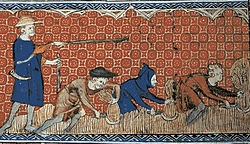Definition and derivation
The derivation of the word is obscure. It may be derived from vassi ad valvas (at the folding-doors, valvae), i.e. servants of the royal antechamber. Du Cange regarded it merely as an obscure variant of vassus, probably from vassus vassorum "vassal of the vassals". [1] Alternative spellings include vavasor, valvasor, vasseur, vasvassor, oavassor, and others.
In its most general sense the word thus indicated a mediate vassal, i.e. one holding a fief under a vassal. The word was, however, applied at various times to the most diverse ranks in the feudal hierarchy, being used practically as the synonym of vassal. Thus tenants-in-chief of the crown are described by Emperor Conrad II as valvassores majores, [2] as distinguished from mediate tenants, valvassores minores. [1]
Gradually the term without qualification was found convenient for describing sub-vassals, tenants-in-chief being called capitanei or barones; but its implication, however, still varied in different places and times. Bracton ranked the magnates seu valvassores between barons and knights; [3] for him they are "men of great dignity," and in this order they are found in a charter of King Henry II of England (1166). But in the regestum of King Philip II Augustus of France we find that five vavassors are reckoned as the equivalent of one knight. [4] Finally, Du Cange quotes two charters, one of 1187, another of 1349, in which vavassors are clearly distinguished from nobles. [1]
Vavasours subdivide again to vassals, exchanging land and cattle, human or otherwise, against fealty. - Motley.
This page is based on this
Wikipedia article Text is available under the
CC BY-SA 4.0 license; additional terms may apply.
Images, videos and audio are available under their respective licenses.
